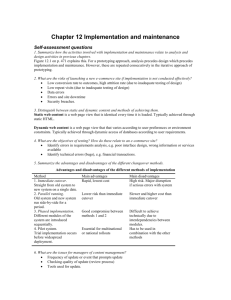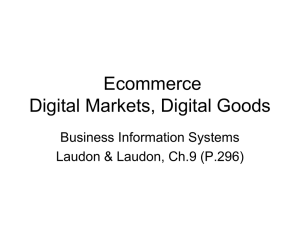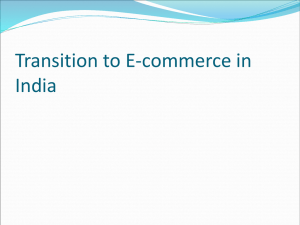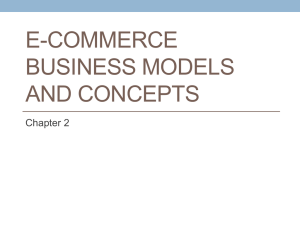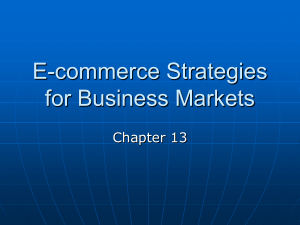The Adoption of eCommerce by Developing Countries: an
advertisement
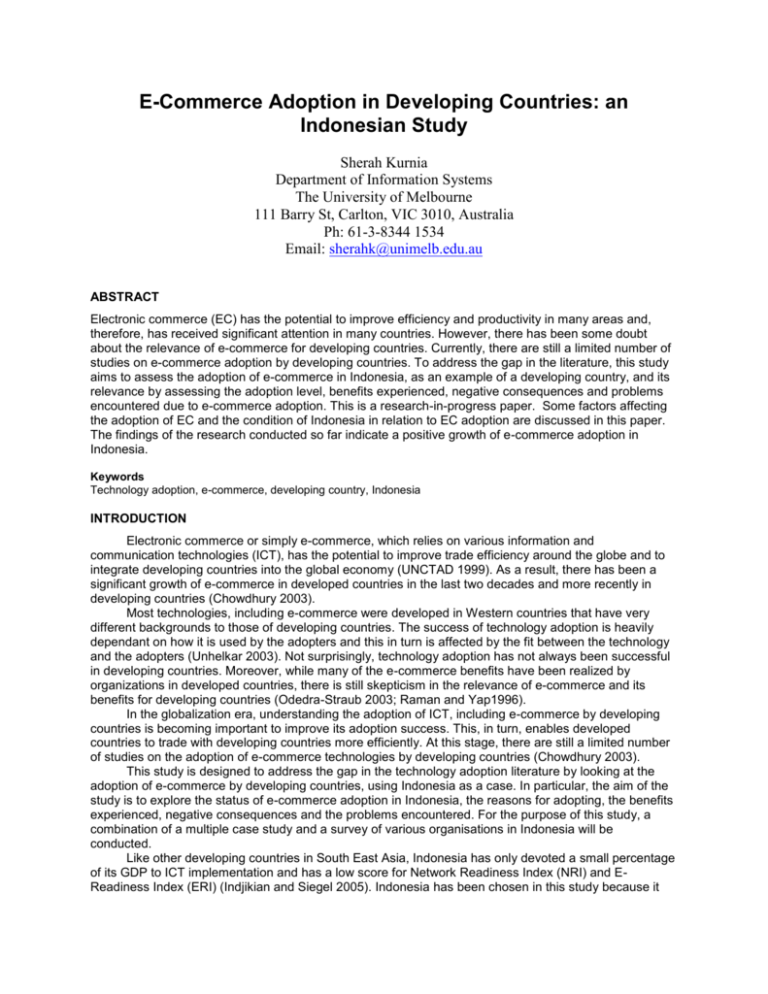
E-Commerce Adoption in Developing Countries: an Indonesian Study Sherah Kurnia Department of Information Systems The University of Melbourne 111 Barry St, Carlton, VIC 3010, Australia Ph: 61-3-8344 1534 Email: sherahk@unimelb.edu.au ABSTRACT Electronic commerce (EC) has the potential to improve efficiency and productivity in many areas and, therefore, has received significant attention in many countries. However, there has been some doubt about the relevance of e-commerce for developing countries. Currently, there are still a limited number of studies on e-commerce adoption by developing countries. To address the gap in the literature, this study aims to assess the adoption of e-commerce in Indonesia, as an example of a developing country, and its relevance by assessing the adoption level, benefits experienced, negative consequences and problems encountered due to e-commerce adoption. This is a research-in-progress paper. Some factors affecting the adoption of EC and the condition of Indonesia in relation to EC adoption are discussed in this paper. The findings of the research conducted so far indicate a positive growth of e-commerce adoption in Indonesia. Keywords Technology adoption, e-commerce, developing country, Indonesia INTRODUCTION Electronic commerce or simply e-commerce, which relies on various information and communication technologies (ICT), has the potential to improve trade efficiency around the globe and to integrate developing countries into the global economy (UNCTAD 1999). As a result, there has been a significant growth of e-commerce in developed countries in the last two decades and more recently in developing countries (Chowdhury 2003). Most technologies, including e-commerce were developed in Western countries that have very different backgrounds to those of developing countries. The success of technology adoption is heavily dependant on how it is used by the adopters and this in turn is affected by the fit between the technology and the adopters (Unhelkar 2003). Not surprisingly, technology adoption has not always been successful in developing countries. Moreover, while many of the e-commerce benefits have been realized by organizations in developed countries, there is still skepticism in the relevance of e-commerce and its benefits for developing countries (Odedra-Straub 2003; Raman and Yap1996). In the globalization era, understanding the adoption of ICT, including e-commerce by developing countries is becoming important to improve its adoption success. This, in turn, enables developed countries to trade with developing countries more efficiently. At this stage, there are still a limited number of studies on the adoption of e-commerce technologies by developing countries (Chowdhury 2003). This study is designed to address the gap in the technology adoption literature by looking at the adoption of e-commerce by developing countries, using Indonesia as a case. In particular, the aim of the study is to explore the status of e-commerce adoption in Indonesia, the reasons for adopting, the benefits experienced, negative consequences and the problems encountered. For the purpose of this study, a combination of a multiple case study and a survey of various organisations in Indonesia will be conducted. Like other developing countries in South East Asia, Indonesia has only devoted a small percentage of its GDP to ICT implementation and has a low score for Network Readiness Index (NRI) and EReadiness Index (ERI) (Indjikian and Siegel 2005). Indonesia has been chosen in this study because it presents a unique and interesting case as a developing nation. It has been undergoing a wide array of economic and political changes in the last few years (Raman and Yap 1996; PWH 2003/2004). Because of globalisation, in particular, the Indonesian government removed the ban on foreign investment in wholesale and retail trading in March 1998 (PWH 2003/2004). As a result, there have been many changes to business competition because of foreign investors and there has also been a rapid ICT investment growth in various business sectors to stay competitive (PWH 2003/2004). It is, therefore, important to assess how these recent changes affect Indonesian organizations’ attitude towards ecommerce technology adoption, since it is believed that competition plays a crucial role in ICT growth (Singh 2000). At this stage, little research has been undertaken into the adoption of e-commerce in Indonesia. Insights into the degree of e-commerce adoption by Indonesian organizations and their adoption experience, which will be obtained from this study, will be valuable for devising appropriate adoption strategies for developing countries. The study findings, although will be further refined over time by extending this study to look at other developing countries, will also contribute to the technology adoption literature. In the next section, the basic concept of e-commerce including the definition, example of ecommerce technologies, stages of growth and benefits, is discussed. Then various factors affecting ecommerce adoption are outlined to guide the remainder of this study in assessing the adoption of ecommerce in Indonesia. A brief overview of e-commerce in Indonesia is then presented and, finally, tentative conclusions and future studies are outlined. E-COMMERCE BASIC CONCEPT There are many differing definitions of e-commerce found in the literature. In its broadest term, ecommerce can be referred to as “a general concept covering any form of business transaction or information exchange executed using information and communication technologies” (Whitely 1998, p.1). E-commerce is not only limited to buying and selling over the Internet, but it is also concerned with transferring or exchanging products/services and/or information via computer networks, including the Internet, Extranet and Intranet (Turban et al. 2006). It includes activities such as servicing customer online, collaborating with business partners and exchanging business documents within an organization over the Internet or other private networks. Because of its broad coverage, e-commerce is often referred to as e-business (Barness and Hunt 2001). Although e-commerce is still a relatively new term within the society, it actually has been around for several decades. The first e-commerce application, Electronic Funds Transfer (EFT), was developed in the early 1970s to allow funds to be routed electronically between financial institutions (Johnston 1998). As an extension to EFT, Automatic Teller Machine (ATM) was introduced in the early 1980s, to enable financial transactions to be carried out over a computer network (Barnes and Hunt 2001). Then Electronic Data Interchange (EDI) was developed later in 1980s to enable a wider application of e-commerce across industries. It allows structured business documents to be exchanged electronically between different computer systems without human intervention (Johnston 1998). In 1990s, the Internet was commercialized and the term e-commerce was introduced. With the availability of the Internet and the popularity of the World Wide Web to access the Internet, e-commerce has grown significantly in the last few years (Turban et al. 2006). McKay and Marshall (2004) propose a model to show e-business Stages of Growth, as shown in Figure 1. This model is consistent with the model of e-commerce development discussed by Le and Koh (2002), which includes four stages namely brochureware, interactions, e-commerce, c-Commerce and ebusiness. As the initial step, many organizations start with a static online presence, which is consistent with the brochureware stage in the latter model. In this stage, organizations use the online presence simply for information dissemination to the other party. Thus, there is only uni-directional communication and typical information included is contact details, products/services information, shareholder information, and job opportunities. Moving up one step to the interactive online presence stage, organizations now have two-way communication with the other party over the Internet. In addition to accessing corporate information, customer can offer feedback and in some cases they can place orders online. The interactive site may also offer personalized information to the customers and capture customer’s profile (Le and Koh 2002). Typically, transactions still cannot be completed online. At the e-commerce stage, customers can complete business transactions online and the organization needs to be capable of managing the business round-the-clock and handling the logistics efficiently. This stage is led by Business-to-Consumer (B2C) e-commerce development. In the internal integration stage, organizations have integrated their online system with the internal IT system to manage their related business activities. The last stage, the external integration stage, is consistent with the c-Commerce and e-business stages discussed in Le and Koh (2002). Organizations typically have established both internal and external collaboration to integrate various business processes. This stage is the concern of the Business-to-Business e-commerce, whose primary focus is on improving the efficiency of supply chain management. Many e-commerce initiatives have been introduced in the last few years within various industry sectors, including Just-in-Time (JIT) for the manufacturing industry, Quick Response (QR) for the apparel industry, Efficient Consumer Response (ECR) for the grocery industry and Collaborative Planning, Forecasting and Replenishment (CPFR) for various industries (Kurt Salmon Associates 1993; Manhattan Associates 1998; Kurnia and Johnston 2003). Investment requirement High External integration Internal integration Electronic commerce Static online presence Interactive online presence No presence Low Level of sophistication, potential benefits High Figure 1. E-business Stages of Growth (McKay and Marshall 2004, pg 11) The model suggests that the higher the stage achieved by an organization in the model, the higher the investment requirement and the more benefits can be expected. There are enormous benefits that organizations can obtain from their investment in e-commerce technologies, which are widely reported in the literature. They include, inter alia, efficiency and productivity gain by reducing or eliminating human intervention in various business operation, for example when automatic identification technologies such as barcode and radio frequency identification are involved (Kurnia and Johnston 2000; Abdolvand and Kurnia 2005), improvement in information sharing and communication within organization and between organizations with the use of email, EDI, information portal on intranet or extranet, and so on, global reach to access more customers and suppliers, enhanced customer service, improved trading partner relationships, reduced trading cycles, transaction cost reduction, extended business hours and improved supply chain management (Singh 2000; Barnes and Hunt 2001; Turban et al. 2006). All this will affect the bottom line performance of organizations and can offer competitive advantage. The previous studies’ findings on the lack of benefits experienced by developing countries are indeed consistent with the e-business Stages of Growth model, since many organizations in these countries have only achieved either the static online presence or the interactive online stage (Molla 2005). However, with limited studies on e-commerce adoption by developing countries, there is a need for a further assessment on the potential impact and the relevance of e-commerce, as well as the opportunity of e-commerce growth in developing countries, by gathering more empirical data from various countries (Singh 2000). FACTORS INFLUENCING E-COMMERCE ADOPTION To explore the relevance of e-commerce and the opportunity of its growth in developing countries, it is important to understand national factors that affect e-commerce adoption. A number of such factors have been identified from the literature as summarized in Figure 2. The figure also demonstrates the influence of each factor on other factors. These factors will be used in developing a research model of EC adoption by developing countries in a later stage of the study, combined with other factors identified at various levels including industry and organizational levels. External Influence Political Condition Government Initiatives Economic Condition Socio-cultural Condition Geographical Condition Technology Infrastructure e-Commerce Adoption Public Awareness Figure 2. Factors Affecting e-commerce Adoption Government Initiatives Government initiatives are important in the adoption of e-commerce and other ICT in general (Molla 2005). They can be in terms of promotion of ICT usage, education and the establishment of adequate regulatory framework for e-commerce including taxation and tariff for revenue generated through ecommerce and Intellectual Property protections. Government initiatives are affected by many factors including the country’s political condition, economic condition, and external influence from other countries. Political Condition Political situation is a key factor for e-commerce growth. In a country with an unstable political condition, it is less likely that government will give enough attention, if any, on e-commerce development (Dedrick et al. 1995). Economic Condition Economic condition is also widely recognized as a major driver for e-commerce adoption. The GDP and income per capita are common indicators for the economic condition of a country. Since e-commerce relies on some technology infrastructures which are relatively expensive for many developing countries, countries with unfavourable economic condition are not likely to be involved in e-commerce (Dedrick et al. 1995). The economic condition will also affect the socio-cultural condition of a country. Technology Infrastructure E-commerce success relies heavily on a number of technology infrastructures. Firstly, telecommunication infrastructures are required to connect various regions and parties within a country and across countries (Molla 2005). The cost of accessing the infrastructures also influences the growth of e-commerce. E-commerce also relies on efficient logistic infrastructures within a country. Its growth further requires the establishment of reliable and secure payment infrastructures to avoid frauds and other illegal actions (Boerhanoeddin 2000). The overall technology infrastructure development of a country relies heavily on the economic and geographical conditions of the country. Geographical Condition Geographical condition of a country can be a motivation or barrier to technology infrastructure development. In countries that consist of many small islands, technology infrastructures can be difficult to develop. On the other hand, the need for having such infrastructure is also significant for effective communication and trading among the widely spread parties (Boerhanoeddin 2000; Minges 2002). Socio-cultural Condition The adoption of e-commerce also depends on the cultural and social environment. In some countries, people consider shopping as a recreation, and therefore, B2C e-commerce is difficult to nurture (Boerhanoeddin 2000). Likewise, the level of education, the availability of IT skills, the level of penetration of personal computers and telephone within the society affect the growth of e-commerce (Raffa et al. 2002). Public Awareness A lack of awareness of the use and potential benefits of ICT can also hinder the growth of ecommerce (Molla 2005, Jennex et al. 2004). In some developing countries, many people are only aware of limited e-commerce applications such as chat, email and browsing websites (Minges 2002). As a result, many organizations have not considered exploiting the potential of e-commerce to improve their business operations. External Influence The growth of e-commerce in a country is also influenced by other countries. For example, the reputation of credit card frauds in some countries caused blockages of several IP addresses by a number of commercial sites from different countries. This situation can cause those countries to be expelled from global business transactions and hence, limit the usefulness of e-commerce (Hidayat 2004). E-COMMERCE IN INDONESIA The Republic of Indonesia, located in South East Asia, comprises more than 12,000 islands. The total area of the country is 9.8 million square kilometers, with the land area of 1.9 million square kilometers and a sea area of 7.9 square kilometers (81%) (Minges 2002). Indonesia has five main islands which are Java, Sumatra, Sulawesi, Kalimantan and Papua. The capital city is Jakarta, which is located in Java Island. In terms of the population, Indonesia is the fourth largest country in the world with a total population of approximately 240 million in 2005 (The Economist Intelligent Unit 2006). The vast majority of the people live in Java. Before 1997, Indonesia’s economic growth was one of the fastest in South East Asia. Because of the economic crisis and political instability faced by Indonesia between 1998 and 1999, there was a decline in the economic performance of the country. The crisis affected the ICT growth in Indonesia. However, with a new President elected in 1999, the economy of Indonesia has been significantly improved, with a stable growth in the GDP since 1999 (Minges 2002). By 2001, Indonesia has made a radical progression in telecommunications development, as a response to global trends and South East Asia region initiatives (TKTI 2001, Castle Asia 2002). In particular, by allowing private sector involvement in telecommunications, Indonesian telecommunication infrastructure has undergone major development. Before 1994, there were only two government telecommunication companies in Indonesia, which were P.T. Telecommunication Indonesia (Telkom) and P.T. Indonesia Satellite Corporation (Indosat). Today, there are several telecommunication providers available in Indonesia. Four companies have a nationwide coverage including P.T. Telkom, which is still the largest and the most influential provider in Indonesia, P.T. Indonesia Satellite Corporation (Indosat), P.T. Satelit Palapa Indonesia (Satelindo) and Excelcomindo. Other telecommunication companies only cover specific regions of Indonesia such as Komselindo (for Jakarta, Bandung, Medan, Manado and Makassar), Netrosel (for central and east Java), and Telesera (for Bali, Kalimantan, and Southern Sumatra) (Minges 2002). The first Internet Service Provider (ISP) in Indonesia is PT Indo Internet (Indonet), which was launched in 1994. By 2004, there are 228 ISP in the country. Indonesian Internet Exchange (IIX) is operated by the Indonesian ISP Association (APJII). All ISPs in Indonesia are members of APJII, who need to connect to the IIX backbone. There has been a radical increase in the number of the Internet subscribers and users in Indonesia (Minges 2002), as shown in Table 1. Although the number of the subscribers and users only make up a very small percentage of the total population in Indonesia, there is a positive growth demonstrated, which will impact the adoption of e-commerce. With a further infrastructure development to reach other regions in Indonesia, it is expected that the Internet use will grow rapidly. In addition, the cost of accessing the Internet including call charges is Rp. 160 per minute, which is equivalent to US 1.5 cents, is still high considering the low average income level in Indonesia (Boerhanoeddin 2000). This also has a great impact on the use of the Internet. Year 1998 1999 2000 2001 2002 2003 2004 2005 No. of Subscribers 134,000 256,000 400,000 581,000 667,000 865,706 1,087,428 1,500,000 % of Population 0.065 0.123 0.189 0.272 0.307 0.393 0.470 0.619 No. of Users 512,000 1,000,000 1,900,000 4,200,000 4,500,000 8,080,534 11,226,143 16,000,000 % of Population 0.249 0.481 0.900 1.963 2.073 3.673 4.859 6.612 Table 1. The Estimate Number of the Internet Subscriber and Users in Indonesia (APJII 2005) The low Internet penetration in Indonesia is also caused by the low transmission speed capacity since most of the connections within the country use copper wires. Only major cities have fiber optic connections, but the ‘last mile’ connections are still through copper wires. The transmission speed in some cities is limited to 19,200 kbps, but most areas have the transmission speed of only 9,800 kbps. At the moment it is difficult for ISPs to increase the bandwidth because of the limited number of subscribers and the volatile Rupiah/US Dollar exchange rate since ISPs pay the connection to the Internet backbone in US dollars, while the subscribers pay in Rupiah (Indonesian currency). As a response to the relatively high cost of having personal connections, public Internet access has been introduced through the establishment of public Internet kiosks or Internet cafes, which are known as "Warung" Internet (Warnet). The Internet cafes are cheaper than a personal connection and provide a solution to the lack of the necessary infrastructure at home or at work (Minges 2002). Therefore, the number of the Internet users is much higher than the number of the Internet subscribers in Indonesia. In terms of e-business readiness, like other developing countries, Indonesia is still at the low end, because of a lack of IT infrastructure especially among individual household and small to medium sized enterprises. Generally, there is still a low level of PC penetration and the cost of Internet access is high. In addition, there is a lack of security measures to facilitate online payment, awareness of the potential of e-business, availability of IT skills and willingness to change business practice (Castle Asia 2002). On the positive side, EDI has already been used by more than 2000 private companies and government agencies and e-mail has been widely used for communication purpose. There are also a number of organizations that have established either static or interactive online presence, mainly as a promotional tool. News portals such as Detikom, Kompas, Jawa Pos are also available and widely accessed by the Internet users. Furthermore, some retail organizations, have established internal network to enable electronic communication and information sharing with various branches in Indonesia. In addition, Internet banking has also been offered by some major Indonesian banks and a number of organizations have been using the service (Castle Asia 2002; Minges 2002). Indonesian government is also proactive in supporting the growth of ICT and e-commerce through various initiatives including improving telecommunication regulatory framework, developing awareness and educational campaign on ICT for government officers, developing measures to support SME’s involvement in ICT and e-commerce, revising tax law to facilitate electronic transaction, facilitating the use of the Internet for teaching and learning, improving national backbone infrastructure, developing local networks for underserved areas and many others (TKTI 2001). This provides some indications that there are opportunities to further exploit e-commerce in Indonesia. Different strategies, substantial and government involvement and a longer time period should be expected to happen with e-commerce adoption in Indonesia because of its unique condition. TENTATIVE CONCLUSIONS AND FURTHER STUDIES Based on the study that has been conducted to date, it appears that e-commerce is indeed relevant to Indonesia, despite the current limitations with the existing infrastructure and other issues related to the economical and socio-cultural conditions. E-commerce may offer excellent opportunities for growth in developing nations like Indonesia. Further research into the Indonesian situation is needed to better understand the adoption issue. In the next step, a research model of EC adoption by organizations will also be developed. The various factors affecting the EC adoption identified in this study will contribute to the development of the research model. Based on the research model, a number of hypotheses will be generated. A survey questionnaire will then be developed to test the hypotheses. Following the survey, a multiple case study will be conducted with a number of Indonesian organizations to further explore various issues identified from the survey study. REFERENCES Abdolvand, N. and Kurnia, S. “The EPC Technology Implications on Cross-Docking,” San Diego International Systems Conference, 2005, USA. 2. APJII – Asosiasi Penyelenggara Jasa Internet Indonesia, Statistik APJII, 2005. 3. Barness, S. and Hunt, B. E-Commerce and V-Business, Butterworth Heinemann, 2001, England. 4. Castle Asia. SMEs and E-Commerce, prepared for the Asia Foundation, 2002. 5. Chowdhury, A. “Information Technology and Productivity Payoff in the Banking Industry: Evidence from the Emerging Markets”, Journal of International Development, (15:6), 2003 6. Dedrick, J., Goodman, S. & Kraemer, K. “Little Engines that could: Computing in Small Energetic Countries”, Association of Computing Machinery, (35), 1995, pp.21-26. 7. Hidayat, Indonesia Kampiun Cyberfraud: Pemerintah Jangan Diam Saja, detiki-Net, 2004, available at: http://jkt1.detikinet.com/index.php?fuseaction=detik.read&tahun=2004&bulan=3&tgl=19&time=1759&idnews=116 255&idkanal=110. 8. Indjikian, R. and Siegel, D.S., “The Impact of Investment in IT on Economic Performance: Implications for Developing Countries “, World Development ( 33: 5), 2005, pp. 681-700. 9. Jennex, M. E., Amoroso, D.L., and Adelakun, O. B2B E-Commerce Infrastructure Success Factors for Small Companies in Developing Countries, 2004, Idea Group Inc. 10. Johnston, R.B. Trading Systems and Electronic Commerce, Eruditions Publishing, 1998. 1. 11. Kurnia, S. and Johnston, R.B. “Adoption of Efficient Consumer Response: Key Issues and Challenges in Australia”, Supply Chain Management: An International Journal, (8:2), 2003, pp 251262. 12. Kurnia, S. and Johnston, R.B. “The Issue of Mutuality in ECR Adoption: A Case Study”. The Eighth European Conference on Information Systems, 2000, Vienna, Austria. pp. 1009-1016. 13. Kurnia, S. and Johnston, R.B. “Adoption of Efficient Consumer Response: Key Issues and Challenges in Australia”. Supply Chain Management: An International Journal, (8: 2), 2003, pp 251-262. 14. Kurt Salmon Associates, Efficient Consumer Response: Enhancing Consumer Value in the Grocery Industry, Food Marketing Institute, 1993, Washington, D.C. 15. Le, T.T.L. and Koh, A.C., “A Managerial Perspective on Electronic Commerce Development in Malaysia”, Electronic Commerce Research, (2), 2002, pp. 7-29. 16. Manhattan Associates. Achieve Total Industry Integration to Meet Quick Response, Efficient Consumer Response and Efficient Foodservice Response Requirements, 1998. 17. Minges, M. Kretek Internet: Indonesia Case Study, 2002, available at: http://www.apjii.or.id/dokumentasi/id_cs.pdf. 18. Molla, A. Exploring the Reality of eCommerce Benefits Among Businesses in a Developing Country, University of Manchester, Precinct Centre, Manchester, 2005, UK, available at: URL: http://www.sed.manchester.ac.uk/idpm/publications/wp/di/index.htm 19. Odedra-Straub, M. “E-commerce and Development: Whose Development?” Electronic Journal on Information Systems in Developing Countries, (11:2), 2003, pp 1-5. 20. PWC - PricewaterhouseCoopers, Indonesia, Retail and Consumer Growth Dynamics From New Delphi to New Zealand, 2003/2004, pp 58-65. 21. Raman, K. and Yap, C. “From a Resource Rich Country to an Information Rich Society: An Evaluation of Information Technology Policies in Malaysia”, Information Technology for Development, (7), 1996, pp.109-131. 22. Singh, A. D. Electronic Commerce: Some implications for firms and workers in developing countries, International Institute for Labour Studies, 2000, Geneva. 23. TKTI – Indonesian Telematics Coordinating Team. Five-Year Action Plan for the Development and Implementation of Information and Communication Technologies (ICT) in Indonesia, 2001. 24. Turban, E. et al. Electronic Commerce: A Managerial Perspective, 2006, Prentice Hall. 25. Unhelkar, B., “Understanding the Impact of Cultural Issues in Global e-Business Alliances”, 4th International WeB Conference, 24-25 Nov, 2003, Perth, Western Australia. 26. UNCTAD - United Nation Conference on Trade and Development. “Can Electronic Commerce be an Engine for Global Growth?” Electronic commerce and the integration of developing countries and countries with economies in transition, International Trade, 19-23 July 1999, Geneva. 27. Whitely, D. E-Commerce: Strategy, Technologies and Applications, 1998, McGraw Hill.



